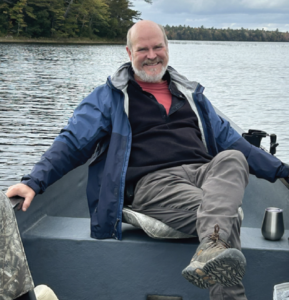
by Lura Jackson, published in the Quoddy Tides, October 25, 2024
The challenges and opportunities of the Greater East Grand Region (GEGR) and Washington County as a whole were addressed during the annual summit of the Sunrise County Economic Council (SCEC) on October 16 at the Danforth town hall. Increased access to housing, promoting outdoor recreational tourism and expanding broadband were the key talking points, along with a celebration of the recent expansion of broadband Internet to all towns between Amity and Waite through a concerted community effort.
“Our remoteness is our major opportunity and our major challenge for economic growth,” said Christopher Hinshaw, executive director of the Greater East Grand Economic Council (GEGEC) during the keynote address, noting that the area comprises 500,000 square acres with about 1,800 year round residents. “This area is something you pass through,” Hinshaw said. To change that, he described focusing on a “three legged stool,” with all parts having equal weight — housing, tourism and broadband.
“Without new housing it is difficult to attract new people and families to the region or help existing local residents move in newer homes that better fit their needs,” Hinshaw stated. He described the example of the recently hired principal of the East Grand School who spent months looking for a nearby residence — and wound up living in a sugar shack in someone’s backyard in the meantime.
Creating affordable, workforce housing
Addressing the lack of affordable housing begins by looking at how the problem started, said John Egan, senior program officer for strategic initiatives at the Genesis Fund. In general, developers have “largely been underbuilding multi-family housing for decades” in response to demand, and the dwindling supply was suddenly challenged by the influx of residents from cities to rural areas. Having 15 to 20 homes taken off the market can create severe shortages in small communities, Egan said.
Short term rentals are another facet to weigh, as while they do remove homes from the long term rental market, the properties are generally being repaired and maintained. “They are a definite wave in the market, largely unregulated,” Egan said. Putting regulations on short term rentals “can really change what is available” within communities. To get a handle on them, Egan recommends that municipalities create community registries logging where short term rental properties are located and how many of them there are.
Ultimately, it’s important to keep in mind that “economic development is housing development, and housing development is economic development,” Egan said.
With that in mind, TIFs — or tax-increment financing — are the “best local tool” that “municipalities are underusing,” said Egan. “A TIF can make all the difference in the world” to developers and towns. “Nearly all the ones I come across are highly successful.”
TIFs aren’t without opposition, particularly at the local level. At municipal meetings, people sometimes say that TIF recipients are taking taxes away from the town. When that happens, it helps to put it in perspective, Egan said — either the town can have 100% of the current revenue on undeveloped property, which is usually near $0, or it can have part of future tax revenue, which is much greater.
The Genesis Fund administers loans and provides networking resources to municipalities at no cost at the behest of Maine Housing, Egan said, and he closed by advising that any municipality could reach out and request a meeting to see what options may be available for advancing housing development at a local level.
Outdoor based recreational tourism as a key draw
Tourism earns its place as a leg of the stool, Hinshaw said, because it not only serves to create an economic engine that fuels sustainable jobs, but it also attracts long term residents and bolsters the case for housing developers. The challenge is scaling up “without harming the very reasons that make this region so special.”
The GEGR is rife with opportunity, said Crystal Hitchings, director of community promotions at SCEC, outlining that the activities in the area “offer the most value in that tourism recreation industry,” and that insights can be gained about why people visit the nearby Downeast region.
People visit Downeast for sightseeing and touring, relaxing and unwinding, visiting friends and family and birdwatching, in order of popularity, Hitchings said. Other elements that draw people Downeast include food, beverage and shopping opportunities — elements that are currently missing from the GEGR.
The focus should be on promoting “heritage based tourism,” Hitchings said. “Instead of just passing through, people are visiting to learn, explore and appreciate a region’s cultural and environmental heritage.”
Creating a unique brand for the area is key, Hinshaw said, along with building infrastructure to support incoming visitors, such as eating establishments, lodging and a regional information center. “I am not the least bit concerned about over development.” However, “if locals don’t do it, an outside entity could come in and do it, bringing in their own idea of what tourism and culture are here.”
To effectively harness the brand identity, “it must be done by local organizations rather than an outside entity,” seconded Cecil Gardner, Downeast Acadia regional tourism coordinator at SCEC.
Outdoor tourism initiatives in the GEGR are being supported by the development of experiential outdoor education in area schools. Tammi Matula, outdoor education teacher at East Grand School and registered Maine guide, outlined how East Grand School has implemented outdoor education for its students going back to 1996 and completed an outdoor education classroom in 2015. Students are learning a plethora of outdoor skills, from whitewater rafting to animal processing to axe usage. “We’re learning to be good stewards” of trails and the natural environment as a whole, Matula said. “Our kids have fun in the outdoors, they value it, and they’re helping to maintain it.”
Broadband expands in GEGR
The rapid expansion of broadband Internet to include all towns between Amity and Waite is “something I would have thought impossible five to 10 years ago,” said Charles Rudelitch, executive director of SCEC, noting that the region had “leapfrogged ahead” of many communities around Washington County and the state.
The development “was not a flash in the pan,” as explained by Dwayne Young, chair of the Regional Broadband Committee. He outlined how, since 2011, efforts have been under way in the region to form partnerships and build capacity for long term sustainability across the board, including introducing land easements, starting the Danforth Livable Community Center and setting aside land for future development. As such, the growth in broadband has been “the result of an investment in the Greater East Grand Region by its residents, local governments, nonprofits and philanthropists over the last 13 years.”
The broadband project was particularly catalyzed during the pandemic when it was recognized that most students were accessing their school work through mobile phones, Young said. Looking for options, the broadband committee found Consolidated Communications and their ongoing work to expand broadband in Maine to be a good fit.
While Consolidated had the desire to move ahead, “It’s very expensive to build a network, and it’s very expensive to come off copper lines and go into a fiber line,” said Simon Thorne of Consolidated. “For us to do that on our own, it was just cost prohibitive.”
Fortunately, funds were available from the Maine Connectivity Authority, opening the door to the project’s development. After the project was funded with an $8.1 million grant in 2023, the physical work began, culminating in the network’s completion earlier this year.
After a total investment of $9.17 million, 1,705 premises in 11 communities were connected through the work of the GEGR Broadband Committee and Consolidated, with an additional 300 or so premises added following the network’s expansion to Vanceboro and Waite.
The broadband network will lead to enhanced education, telehealth and the ability to work remotely, along with a better multi user home experience, Hinshaw said.
To illustrate the possibilities now open to the community, Elaine Abbott, regional broadband coordinator for SCEC, discussed a digital equity pilot program that will soon be under way at the East Grand School. Through the program, students will assemble 20 computers piece-by-piece and then engage in teaching others in the community how to use them. In addition, through a partnership with Washington County Community College, the students can enroll in a Google Certificates course that will, after about five months of training for 10 hours a week, make them eligible for entry level careers beginning at $70,000 a year.
With the three legs of the stool — housing, tourism and broadband — being addressed, Hinshaw is optimistic about the region’s prospects for development. At the same time, he said, introducing new elements thoughtfully and carefully is required, particularly to prevent residents from feeling overwhelmed. “We know we need change, but we also wish to remain the same.”





